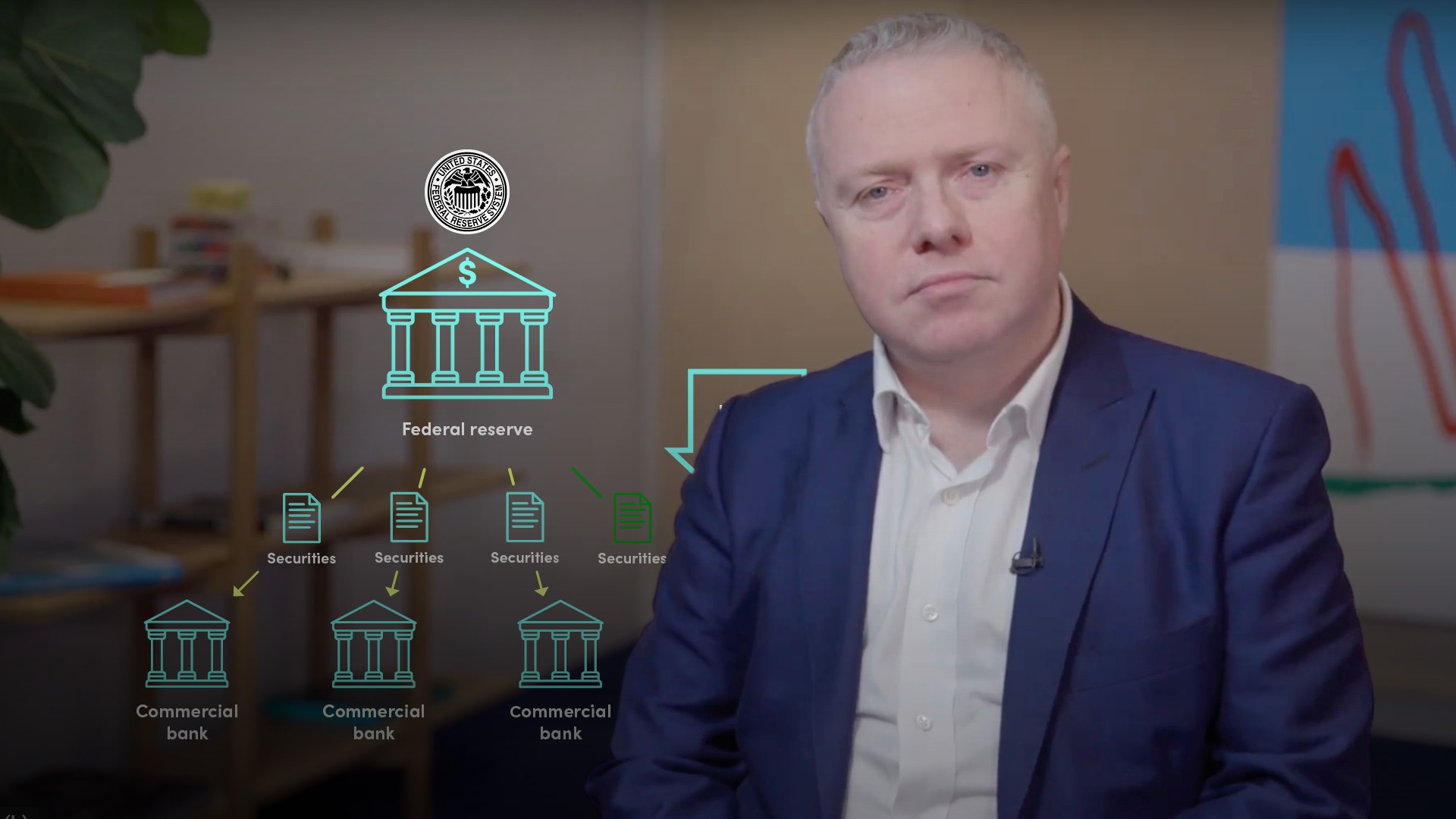
The Use of QE following the 2008 Financial Crisis

Trevor Pugh
20 years: Trading & hedge funds
Although QE seemed like a completely new direction from central banks when it was launched in 2009, neither the idea of central banks buying bonds on the open market, nor the concept of QE itself were new. In this video, Trevor explains the history of QE, how it works in theory and how it works in practice.
Although QE seemed like a completely new direction from central banks when it was launched in 2009, neither the idea of central banks buying bonds on the open market, nor the concept of QE itself were new. In this video, Trevor explains the history of QE, how it works in theory and how it works in practice.

The Use of QE following the 2008 Financial Crisis
21 mins 6 secs
QE was launched in 2009 by the BOE and the Federal Reserve to combat the effects of the global Financial Crisis. It involved the creation and exchange of central bank reserves for bonds in the hope of increasing money supply in the private sector and lowering credit costs.
Key learning objectives:
Define QE, identify the ways it works and its execution methods
Identify QEs various impacts on the economy
Learn the examples of QE in use
What are the types of Central Bank operations?
- Discount Operations
- These are done at the initiative of the commercial banks whereby they sell or lend securities to the central bank in order to obtain reserves.
- Open Market Operations (OMOs)
- These are done at the initiative of the central bank, and are conducted by the central bank’s dealing desk which buys and sells securities in order to implement monetary policy - QE falls within this bracket.
What is QE, and how does it work?
Quantitative Easing - This a policy whereby the central bank expands its balance sheet by buying bonds from the market using newly created central bank reserves. Reserves are also known as ‘base’ or ‘high-powered’ money and are used by commercial banks to settle debts between them.
Both the asset and liability side of the balance sheet increase. The asset side increases due to the bonds it has purchased in the market, and the liability side increases by the amount of central bank reserves that have been created in order to purchase those bonds. Central banks have a monopoly on the creation of central bank reserves, and are not limited in their ability to do this.
What are some examples of the ECB using QE?
ECB QE Programme - The Asset Purchase Programme: These consisted of four separate programmes:
- Public Sector Purchase Programme (PSPP): 2.1tn EUR
- Corporate Sector Purchase Programme (CSPP): 206bn EUR
- Asset Backed Securities Purchase Programme (ABSPP): 31bn EUR
- Third Covered Bond Purchase Programme (CBPP3): 277bn EUR
The ECB also engages in:
- Long Term Repo Operations (LTROs) - Where liquidity is provided to banks for periods of three years.
- Targeted Longer Term Refinancing Operations (TLTROs) - These were offered to banks for periods of up to four years, where the interest rate was linked to bank lending in the real economy.
In what ways did QE impact the economy?
- Confidence
- The fact that central banks were operating in markets at such a large scale is something that most participants had simply never experienced. QE provided renewed confidence in central bank power
- Policy signalling
- During the period, although short dated rates were very low, the yield curve remained very steep as investors assumed higher rates again in the future. Engaging in QE was a sign that loose monetary policy was “here for some time”, and as such had the impact of pulling longer rates lower or ‘flattening the curve’
- Portfolio rebalancing
- In any crisis, there is a stampede into risk-free assets and strong currencies. Central Banks, by buying risk-free assets and lowering the yields on them, making it more attractive for investors to switch to riskier products, i.e. corporate bonds and equities. As a result, the S&P 500 went from a low of 666 at the start of QE in the US, to 2000 three years later
- Market liquidity
- At the time of QE, banks were struggling with the poor quality of assets on their balance sheets. QE was of huge assistance in lightening up these balance sheets. Before the FR started buying government bonds, the FR was buying mortgage bonds from primary dealers. Banks also struggled to take on the assets of SPVs. Banks were also holding the positions of clients who had no choice but to fold up and sell every position. QE rectified this as the Federal Reserve bought back mortgage securities directly from banks, reducing their positions in these securities that were becoming difficult to sell
- Money
- By adding more reserves to the banking system, it was thought this would create more money overall in the private sector. However, there must first be a demand for money and credit, and secondly, there was never a reserve constraint in the first place. The BOE created £200bn in central bank reserves during the first rounds of QE
- Currency Effects
- This is the idea that by lowering the yield or return on safe assets in the country, the demand for the currency will be lowered. This makes goods and services produced in the country cheaper to overseas buyers, and so exports are boosted
What were the reasons for excluding short and long dated bonds?
- Short dated bonds - The largest holders were overseas clients such as central banks, and the general feeling was that creating reserves to purchase bonds from overseas holders would be of little benefit to the domestic economy. Similarly, if the market expected rates to stay low, then front end yields would remain low, QE would be of no additional benefit in this area.
- Long dated bonds - There was a fear of crowding out pension funds who needed long dated bonds to match their long-dated liabilities.
What are the two main approaches to executing QE?
- Auction Process - This is where the central bank announces in advance the exact size it will be buying and the time and date. This allows market participants to prepare and manage their risk around the event with a high degree of certainty. The advantage is that it offers certainty for the market, and it is a level playing field as all primary dealers have equal access rights to the operation
- Request for Quote - The client chooses the size they wish to trade in and then asks a price from a small selection of dealers before choosing the dealer with the best price. The difficulty of this process for the market is that dealers have no certainty over when bonds will be bought.

Trevor Pugh
There are no available videos from "Trevor Pugh"

